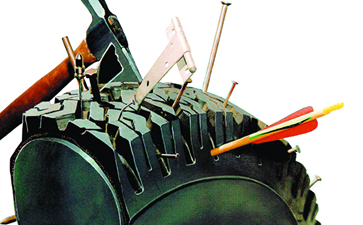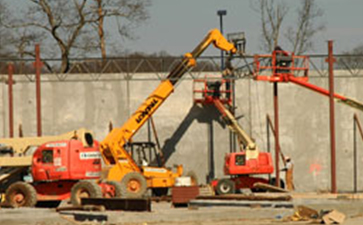The Upside to Selecting Tire Fill over Solid Tires
Construction fleet managers and Off-the-Road (OTR) equipment operators are confronted with many decisions when it comes to managing for greater profitability and success on the job. With a plethora of project verticals to manage (from materials procurement, to regulatory compliance, labor oversight, and stringent budget contracts and timelines), it’s critical that each logistical avenue be as streamlined as possible.
One area that is central to the smooth facilitation of any busy construction work zone—or waste management, agribusiness or mining site operation—is transportation. Whether it’s a telehandler or wheel loader clearing debris and hauling building supplies, or an OTR mining vehicle working in treacherous underground conditions, or even a tractor or harvester preparing crop fields, this equipment keeps the project environment advancing. Ensuring that the project stays on schedule and within fiscal limitations is no small feat.
If any of these large vehicles become dysfunctional, operators quickly lose valuable time and bottom-line profits. In addition to a potential equipment mechanical breakdown, the other number one consideration for equipment managers is tire selection. And, tire solutions vary greatly depending on the OTR environment.
Solid aperture tires are one option. Air-filled pneumatics are another. Tires filled with polyurethane tire fill are a third choice. Tire fill (also known as “foam fill”) technology offers a formulation that blends the best of both worlds (keeping tires virtually flat free, but offering a more cushioned, smoother ride that is less fatiguing for operators required to pull long shifts behind the wheel.) Tire fill has been in use for nearly 50 years, but it has gained measurable traction in recent decades as project managers have become more keenly aware of the devastating hit job site production will certainly take if an unexpected flat prevents either critical supply movement, or more importantly, causes serious crew member injury.
While solid tires also deliver puncture-free benefits, they do not offer as many choices as tire filled-pneumatics. The technology has been in use since the mid-1800s. Solid rubber tires were invented soon after vulcanization (the process of heating rubber with sulfur). They are strong, and resist cuts and abrasions. However, there are some downsides to solid aperture tire products—and as tire technology has advanced, operators looking for puncture-free solutions plus myriad other benefits may find that there are more robust offerings on the market today.
Solids are limited in several key areas including deflection, traction, ride comfort, and the fact that operators are generally restricted to slower speeds. They just don’t handle fast driving, so while they do keep the vehicle in operation longer due to their ability to resist punctures, as cited in Tire Business, “you have a trade-off there of down time vs. a little bit slower movement on the equipment.” Generally, if an operator takes the vehicle or equipment to the same speed as they would pneumatic tires, solids typically will heat up in the center and can blow out. That’s why the decision to select solid aperture tires often depends on the work environment and the specifics of a company’s operations—in determining whether slower speed is better than down time from tire flats due to work site debris.
In the same September 2018 Tire Business article, it was solid tire manufacturers who directly pointed out additional downsides to consider, when using their technology. For example:
- The biggest downside to a solid tire, besides that fact that operators can’t drive fast, is the fact that “you don’t get the same traction with the solid tire that you’re going to get with a pneumatic tire because you get virtually no deflection.
- Solid tires don’t cushion machinery the way pneumatic tires do.
- One thing not always readily considered is roll over protection standards (ROPS) that all equipment OEMs must calculate for safe use of vehicles. It’s important for users to know whether the additional weight of the solid tire creates any problems with ROPS ratings.
- Tradeoffs that a fleet can experience when moving to solid tires are ride quality and reduced heat dissipation.
As these issues are readily acknowledged by the solid rubber tire manufacturer industry for OTR equipment applications, operators should heed the advantages and disadvantages while making tire purchase decisions.
Adapting tire fill technology—such as Carlisle TyrFil, which has been the gold standard solution for more than four decades—frees operators from having to worry about any of the above scenarios affecting solid tire performance.
Tire fill is virtually flat free and can easily glide over sharp rocks, nails, glass and rebar without puncture or risk of incident—offering the same on-the-job sturdiness as solids, but it also offers a host of other measurable benefits. Using tire fill, operators can choose their preferred durometer. The technology is immune to blowouts. It offers a significantly smoother, less bumpy ride, which is far preferable for operator well-being and vastly reduces the risk of Whole Body Vibration (WBV), a serious muscular-skeletal condition that can result from repeated jarring of vehicle axles that can, in turn, impact both humans and the integrity of the equipment they’re operating.
Products like TyrFil are also eco-friendly and offer a sustainable choice for conservation-minded companies working across vertical industries looking to minimize their carbon footprint. Solid tires fill our global landfills by the thousands each and every month, and take years to breakdown, if ever. They create a serious risk for “tire fire” generation, are not biodegradable, and can promote water-pooling that breeds unsafe vector borne disease.
If you’re looking to increase the upside for your tire technology selection, and decrease the cost (fiscal and otherwise) of your investment, don’t just take our word for it. Listen to the experts who actually produce solid rubber tires and heed their discussion about the disadvantages. Become educated about the “road blocks” worth considering when it comes to securing a 360 degree tire care solution that is well-rounded, from both a performance and flatproofing technology point of view, while also being kind to our environment.
For more information, please contact a Carlisle TyrFil representative here.


